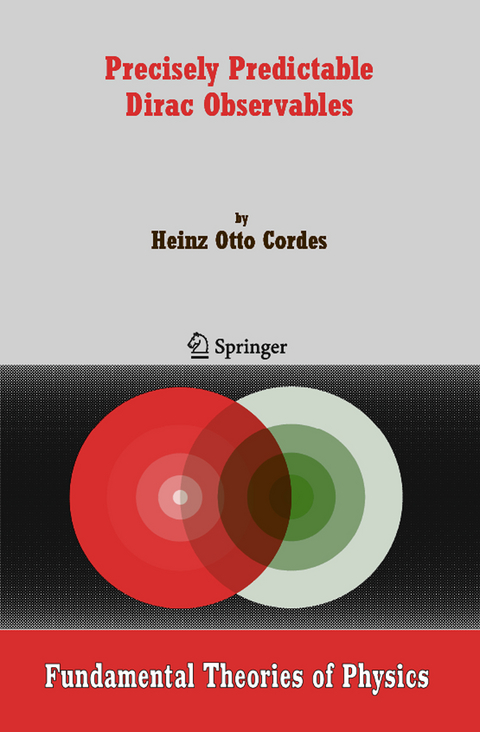
Precisely Predictable Dirac Observables
Seiten
2010
|
Softcover reprint of hardcover 1st ed. 2007
Springer (Verlag)
978-90-481-7299-3 (ISBN)
Springer (Verlag)
978-90-481-7299-3 (ISBN)
For the quantum mechanical 1-body problem (with vanishing potentials) let 1 us focus on 3 di?erent wave equations : (I) The Klein-Gordon equation 3 2 2 2 2 (1) ? =0 , ? = Laplacian = ? Hereitmaybenotedthattheoperator1??hasawellde?nedpositive square root as unbounded self-adjoint positive operator of the Hilbert 2 3 spaceH = L (R ).
In this book we are attempting to o?er a modi?cation of Dirac’s theory of the electron we believe to be free of the usual paradoxa, so as perhaps to be acceptable as a clean quantum-mechanical treatment. While it seems to be a fact that the classical mechanics, from Newton to E- stein’s theory of gravitation, o?ers a very rigorous concept, free of contradictions and able to accurately predict motion of a mass point, quantum mechanics, even in its simplest cases, does not seem to have this kind of clarity. Almost it seems that everyone of its fathers had his own wave equation. For the quantum mechanical 1-body problem (with vanishing potentials) let 1 us focus on 3 di?erent wave equations : (I) The Klein-Gordon equation 3 2 2 2 2 (1) ? ?/?t +(1??)? =0 , ? = Laplacian = ? /?x . j 1 This equation may be written as ? ? (2) (?/?t?i 1??)(?/?t +i 1??)? =0 . Hereitmaybenotedthattheoperator1??hasawellde?nedpositive square root as unbounded self-adjoint positive operator of the Hilbert 2 3 spaceH = L (R ).
In this book we are attempting to o?er a modi?cation of Dirac’s theory of the electron we believe to be free of the usual paradoxa, so as perhaps to be acceptable as a clean quantum-mechanical treatment. While it seems to be a fact that the classical mechanics, from Newton to E- stein’s theory of gravitation, o?ers a very rigorous concept, free of contradictions and able to accurately predict motion of a mass point, quantum mechanics, even in its simplest cases, does not seem to have this kind of clarity. Almost it seems that everyone of its fathers had his own wave equation. For the quantum mechanical 1-body problem (with vanishing potentials) let 1 us focus on 3 di?erent wave equations : (I) The Klein-Gordon equation 3 2 2 2 2 (1) ? ?/?t +(1??)? =0 , ? = Laplacian = ? /?x . j 1 This equation may be written as ? ? (2) (?/?t?i 1??)(?/?t +i 1??)? =0 . Hereitmaybenotedthattheoperator1??hasawellde?nedpositive square root as unbounded self-adjoint positive operator of the Hilbert 2 3 spaceH = L (R ).
Dirac Observables and ?do-s.- Why Should Observables be Pseudodifferential?.- Decoupling with ?do-s.- Smooth Pseudodifferential Heisenberg Representation.- The Algebra of Precisely Predictable Observables.- Lorentz Covariance of Precise Predictability.- Spectral Theory of Precisely Predictable Approximations.- Dirac and Schrödinger Equations; a Comparison.
| Erscheint lt. Verlag | 18.11.2010 |
|---|---|
| Reihe/Serie | Fundamental Theories of Physics ; 154 |
| Zusatzinfo | XIX, 269 p. |
| Verlagsort | Dordrecht |
| Sprache | englisch |
| Maße | 160 x 240 mm |
| Themenwelt | Mathematik / Informatik ► Mathematik |
| Naturwissenschaften ► Physik / Astronomie ► Allgemeines / Lexika | |
| Naturwissenschaften ► Physik / Astronomie ► Mechanik | |
| Naturwissenschaften ► Physik / Astronomie ► Quantenphysik | |
| Naturwissenschaften ► Physik / Astronomie ► Theoretische Physik | |
| Technik ► Maschinenbau | |
| ISBN-10 | 90-481-7299-3 / 9048172993 |
| ISBN-13 | 978-90-481-7299-3 / 9789048172993 |
| Zustand | Neuware |
| Haben Sie eine Frage zum Produkt? |
Mehr entdecken
aus dem Bereich
aus dem Bereich
Band 1: Mechanik und Thermodynamik
Buch | Softcover (2022)
Wiley-VCH (Verlag)
39,90 €
für Studierende der Naturwissenschaften und Technik
Buch | Hardcover (2024)
Springer Spektrum (Verlag)
79,99 €


